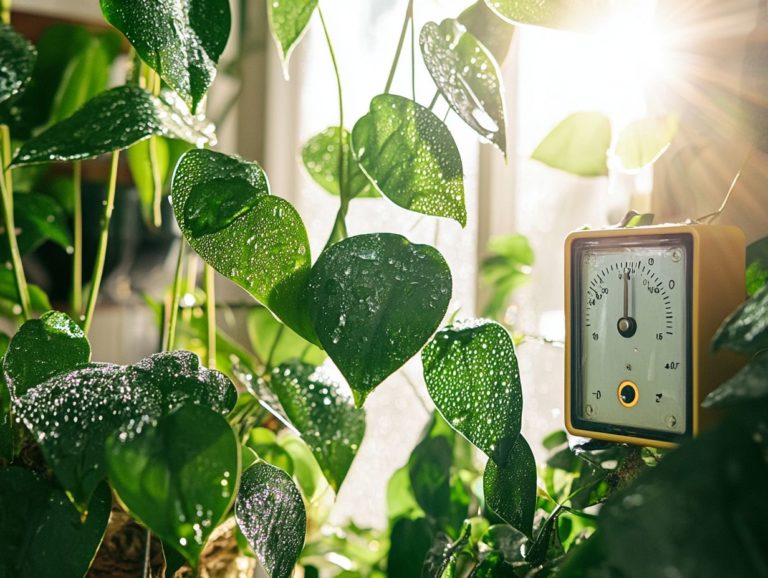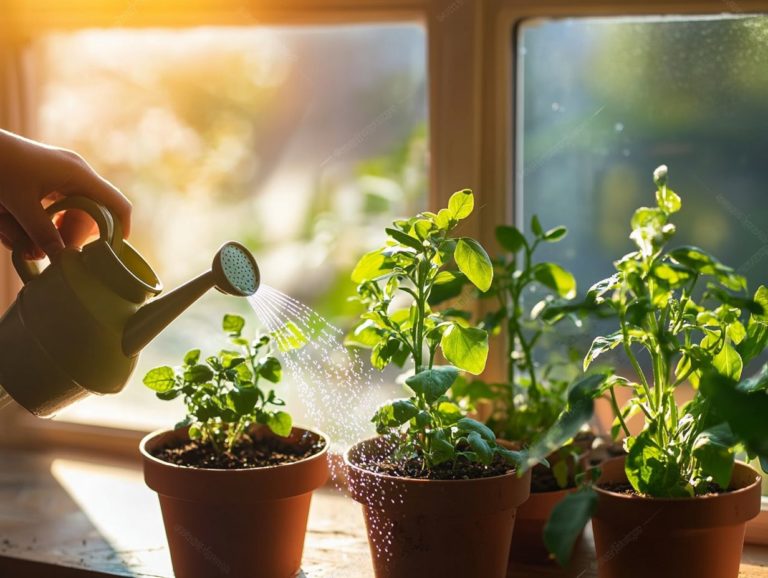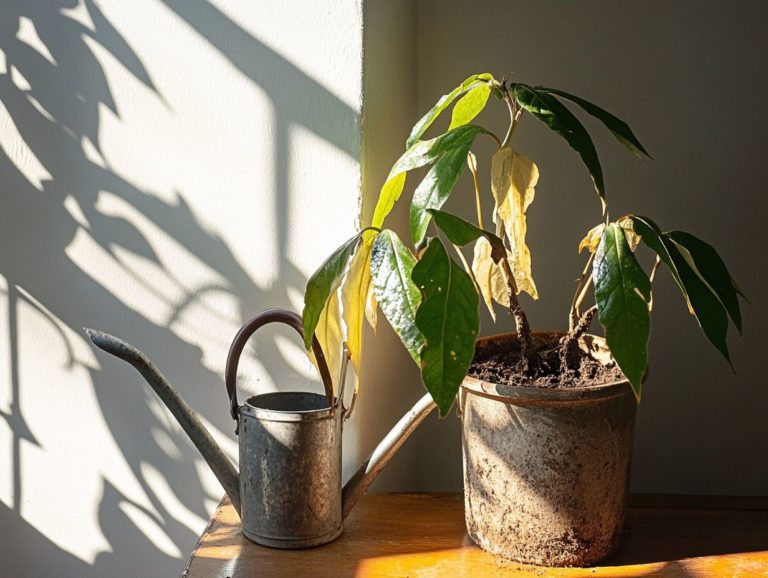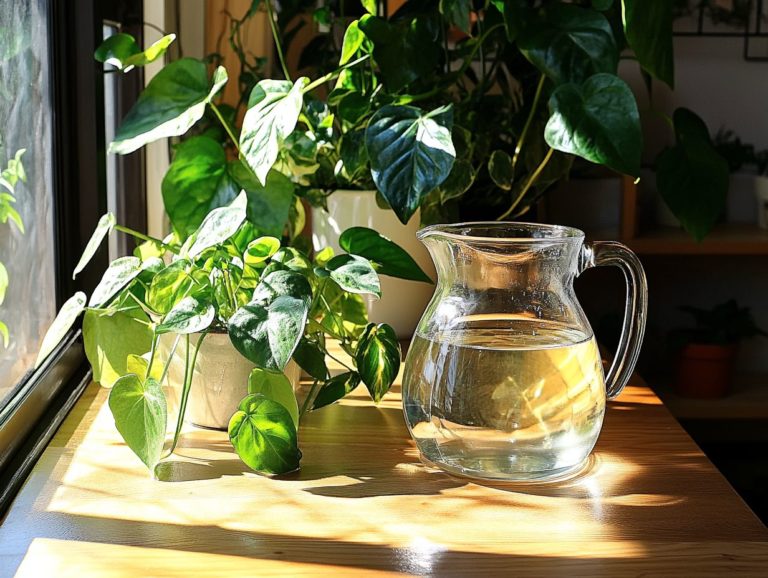Watering Techniques for Ferns: A Care Guide
Ferns can elevate the beauty of any garden or indoor space. Understanding how to water them properly is crucial for their vitality, especially for varieties like the Boston fern.
This article dives into the diverse types of ferns and their natural habitats. It will guide you to recognize the signs of both under and overwatering, which can lead to unhealthy ferns.
You ll uncover effective watering techniques, essential environmental factors, and customized watering schedules tailored to various fern varieties. This ensures their healthy growth.
Whether you re nurturing ferns indoors or outdoors, you ll discover invaluable tips to help your leafy companions thrive.
Contents
Key Takeaways:
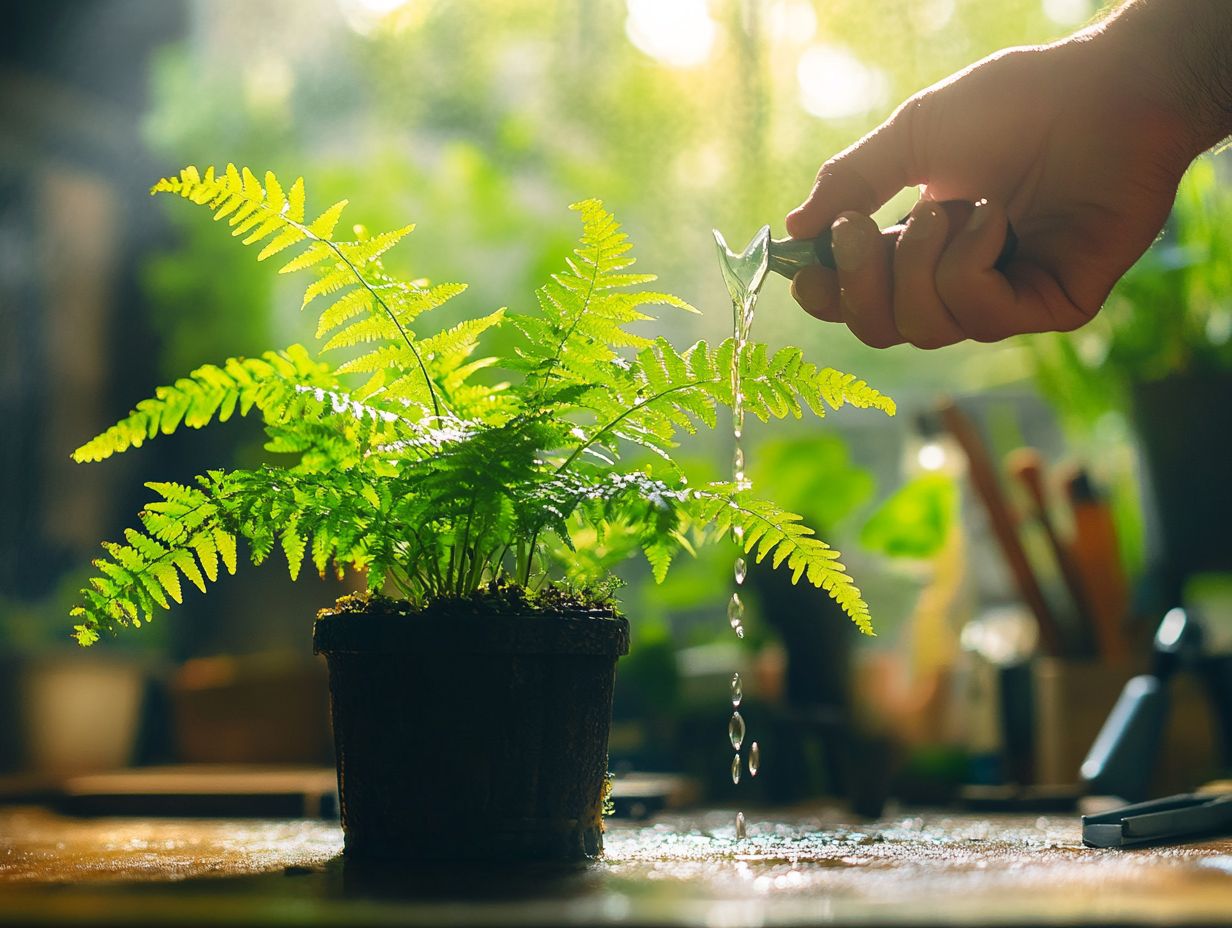
- Know your ferns’ natural habitat to water them right!
- Address signs of over or underwatering, such as yellowing or wilting leaves, promptly to maintain your ferns’ health.
- Consistency is key! Use room temperature water and water the soil directly for healthy ferns.
Understanding Ferns and Their Watering Needs
Ferns, especially the Boston fern (Nephrolepis exaltata), flourish in tropical environments. They boast lush fronds and striking greenery, making them popular choices for indoor cultivation. However, understanding their specific watering requirements is crucial for their overall well-being.
To provide the best care, pay close attention to factors like humidity levels, light exposure, and the appropriate soil composition. Use a well-draining potting mix to avoid root rot, a condition where plant roots decay due to excess moisture. By paying attention to these details, you can help your ferns thrive!
Types of Ferns and Their Ideal Conditions
You ll find a variety of ferns, with the Boston fern (Nephrolepis exaltata) standing out as a favorite for indoor cultivation due to its adaptability to indoor conditions. Originating from tropical rainforests, this plant excels in conditions of humidity and light. Therefore, monitoring these factors closely is essential.
This species flourishes in environments with high moisture levels and filtered sunlight, resembling its native habitat. Beyond the Boston fern, you may also appreciate other varieties like the Maidenhair and Staghorn ferns, which thrive in similar conditions.
These lush tropical environments, abundant in organic material and warmth, create an ideal ecosystem for fern growth. They adapt beautifully to various settings whether nestled in pots indoors or gracing shaded gardens outside benefiting from proper drainage and moisture retention. Their resilience and adaptability make these verdant plants a beloved addition to diverse households, bringing a touch of nature’s elegance into everyday life.
Signs of Under and Overwatering Ferns
Recognizing the signs of under and overwatering is essential for maintaining your ferns’ health. Both conditions can lead to wilting leaves or yellowing foliage, significantly impacting the plant’s overall vitality and growth.
Establishing a consistent watering schedule and closely monitoring moisture retention in the soil will help you avoid problems like root rot and ensure healthy fronds that flourish.
Identifying and Addressing Watering Issues
Identifying and addressing watering issues in your ferns is key to ensuring their lush growth and vibrant appearance. This is essential for their overall health. Problems like root rot often show up as yellowing leaves or droopy fronds. So, it s crucial to stay vigilant!
Watch for signs of underwatering as well. If you notice crispy or brown leaf edges, your fern is telling you it s not getting enough moisture. This indicates the need for better watering practices. Monitoring these indicators can be highly beneficial; you may need to adjust your watering frequency to find that sweet spot.
Improving soil drainage is also important. Using a well-draining potting mix helps maintain moisture levels while keeping roots from becoming waterlogged, thus avoiding temperature shock. Regularly checking the soil s moisture level enables you to fine-tune your care routine, enhancing the health and vibrancy of your cherished ferns.
Watering Techniques for Healthy Ferns
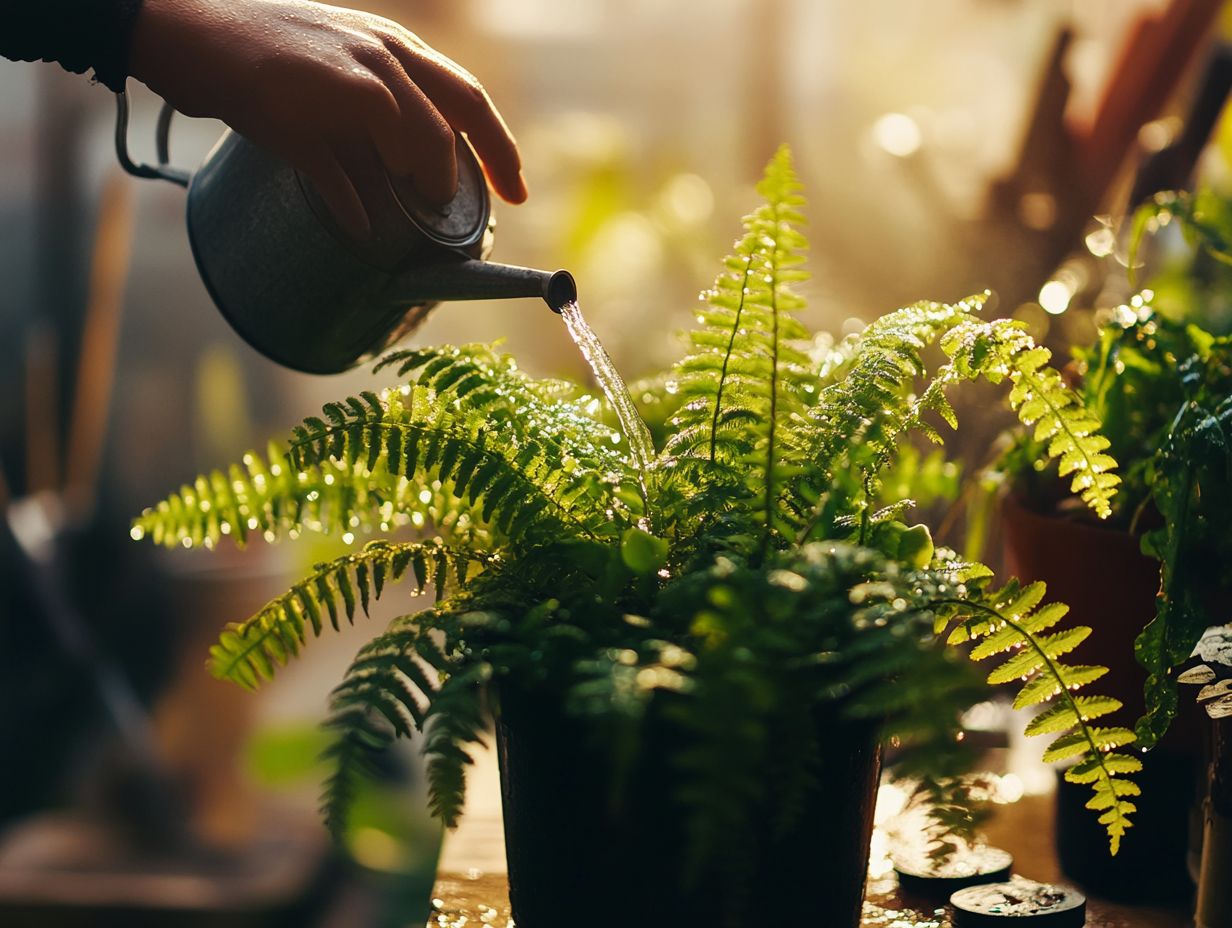
Using smart watering techniques is essential for the care of ferns. These plants flourish in moisture-rich environments, requiring a delicate balance between adequate watering especially during summer and proper drainage.
Avoid waterlogged soil, as it can damage their shallow root system. Techniques like misting and using a watering can with a gentle spout help maintain ideal moisture levels while steering clear of overwatering pitfalls.
Best Practices for Watering Ferns
Implementing best practices for watering your ferns ensures they get essential nutrients and moisture retention. This helps them thrive and showcase vibrant foliage. By incorporating organic matter into the soil and adding Epsom salt for a boost of magnesium, you enhance nutrient availability and encourage robust growth in both indoor and outdoor varieties!
To achieve optimal results, carefully assess the soil composition. Using a well-draining pot with drainage holes is key; it prevents root rot while allowing excess moisture to escape both vital for maintaining fern health.
Understanding the specific water needs of different fern species is crucial. Some prefer consistently moist conditions, while others do better with a bit of drying out between waterings. Regular assessment is key! Check soil moisture levels with a simple finger test to guide your timing for watering.
Don t forget to supplement with diluted liquid fertilizer every few weeks to support healthy foliage, especially during the growing season.
Factors to Consider when Watering Ferns
Grasping the factors that influence how to water ferns like light, temperature, and humidity levels is crucial for their growth. These elements significantly impact their needs and watering schedule, especially as the seasons shift.
Tropical ferns thrive on consistent humidity and indirect sunlight. It s essential to monitor these conditions closely to foster healthy fronds and vibrant leaves that enhance your indoor garden aesthetic.
Start monitoring your ferns today for the lushest growth!
Light, Temperature, and Humidity
Light, temperature, and humidity are essential environmental factors that are important for ferns. This is especially true for those hailing from tropical regions, where indirect sunlight is common and higher humidity is the norm.
Understanding how to provide these elements effectively can significantly enhance your fern’s vitality. Most ferns thrive in bright, filtered light. Position them near windows with sheer curtains to shield their delicate leaves from harsh, direct sunlight, which can scorch them.
Temperature consistency is vital. Keeping the range between 60 F to 75 F is ideal for optimal growth. Use a humidity meter to measure levels between 40% and 60%, adjusting as needed.
To boost humidity, group your plants together or employ a pebble tray filled with water beneath the pots. This allows moisture to rise naturally. By addressing these factors, you’ll be well on your way to nurturing healthy, vibrant ferns that bring joy both indoors and outdoors, contributing to a lush landscape in your garden.
Watering Schedule for Different Types of Ferns
Let s dive into how you can keep your ferns thriving! Establishing a watering schedule that caters to the specific needs of various ferns whether they reside indoors or outdoors is essential for their growth and vitality. This helps prevent issues like wilting leaves, especially during the changing seasons, which can influence their moisture requirements.
For example, tropical ferns may demand more frequent watering during the warm summer months. In winter, when moisture evaporation decreases, they may need much less to maintain their lush appearance. Tailoring your approach will ensure your ferns thrive year-round.
Recommended Watering Frequency for Common Ferns
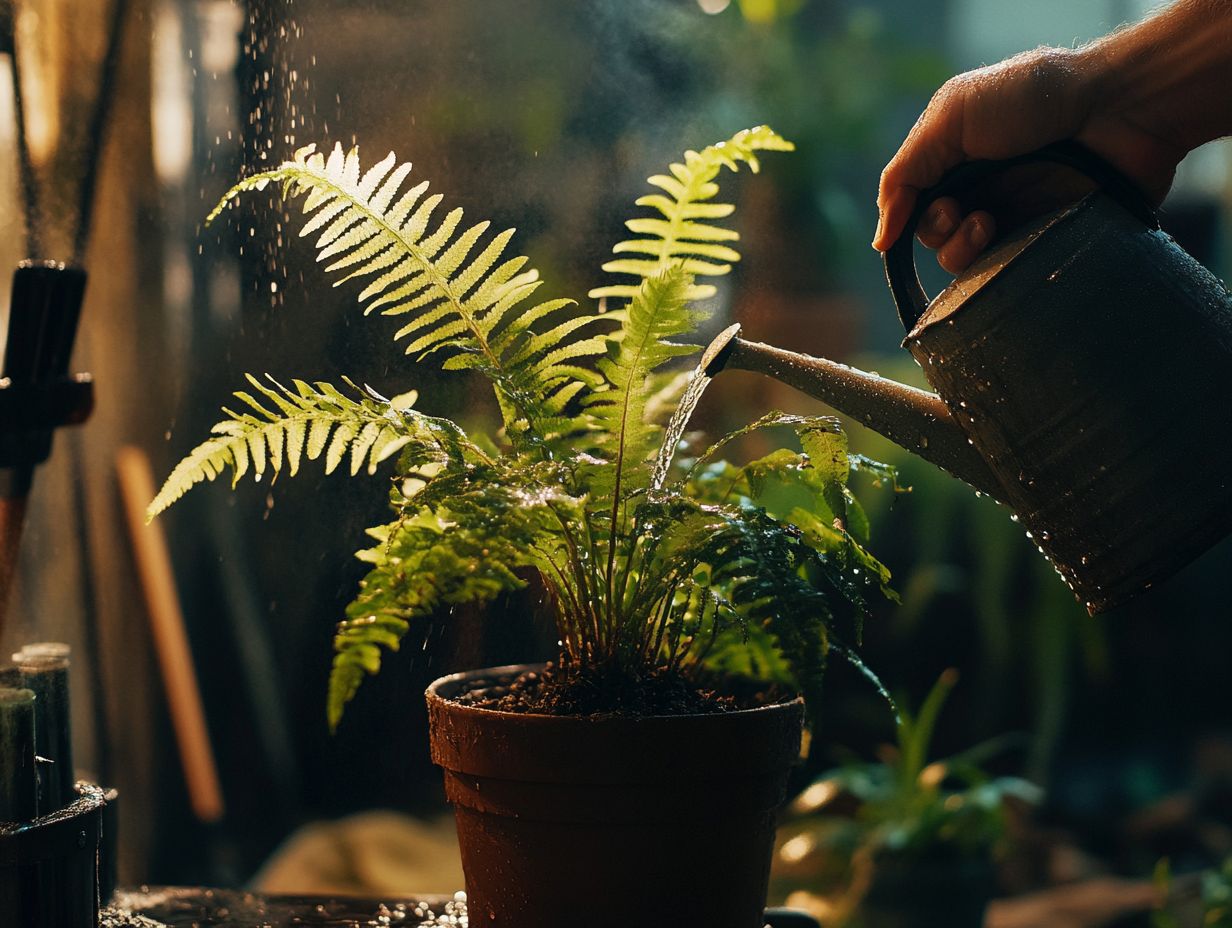
Regarding common ferns like the Boston fern, the key to watering lies in maintaining consistent moisture levels. You ll typically need to water every few days during warm, humid conditions, but you can ease up in cooler, drier seasons.
This frequency can vary significantly based on several environmental factors, including temperature, humidity, and the specific potting medium you re using, such as sphagnum peat moss for moisture retention. For example, if your fern is basking in a bright, sunny spot, it will likely require more frequent watering compared to one tucked away in a shaded corner.
Monitor your plant s health and act quickly if you notice any wilting or yellowing leaves! Your fern’s health depends on it! Make it a habit to regularly check the moisture levels preferably by feeling the soil a few inches down or using a moisture meter for accuracy.
This simple practice will help you fine-tune your watering schedule, ensuring that your fern remains vibrant and thriving.
Tips for Watering Ferns in Different Environments
When it comes to watering ferns, grasping the nuances between indoor and outdoor environments is vital. Factors like humidity, light exposure, and seasonal shifts can greatly impact their watering requirements and routines.
Indoor ferns often thrive with more frequent misting and a carefully managed watering schedule. Conversely, outdoor ferns tend to flourish with natural rainfall, requiring less hands-on care during wetter periods.
Watering Ferns Indoors vs. Outdoors
Watering techniques for ferns vary significantly based on their living environment. When you keep ferns indoors, they often crave that extra humidity. You can provide this through misting. In contrast, outdoor ferns tend to flourish with natural rainfall and enjoy a bit more sunlight.
For your indoor ferns, keep an eye on your soil moisture; your ferns will thank you with vibrant growth! They can easily dry out in heated or air-conditioned spaces. A clever technique you might consider is placing the pot on a tray filled with pebbles and water; this helps create the humidity they so desire.
Outdoor ferns thrive on natural rainfall and should ideally be situated in shaded or partially shaded areas to avoid sunburn. Their watering needs are generally less demanding. However, during extended dry spells, you may need to step in with some extra watering.
By keeping a keen eye on light conditions and humidity levels, you can ensure that both indoor and outdoor ferns reach their fullest potential, boasting lush, vibrant foliage.
Frequently Asked Questions
What are the best watering techniques for ferns?
The best watering technique for ferns is to keep the soil consistently moist but not waterlogged. This means watering once or twice a week, depending on the humidity and temperature of your environment.
How do I know if I am overwatering my ferns?
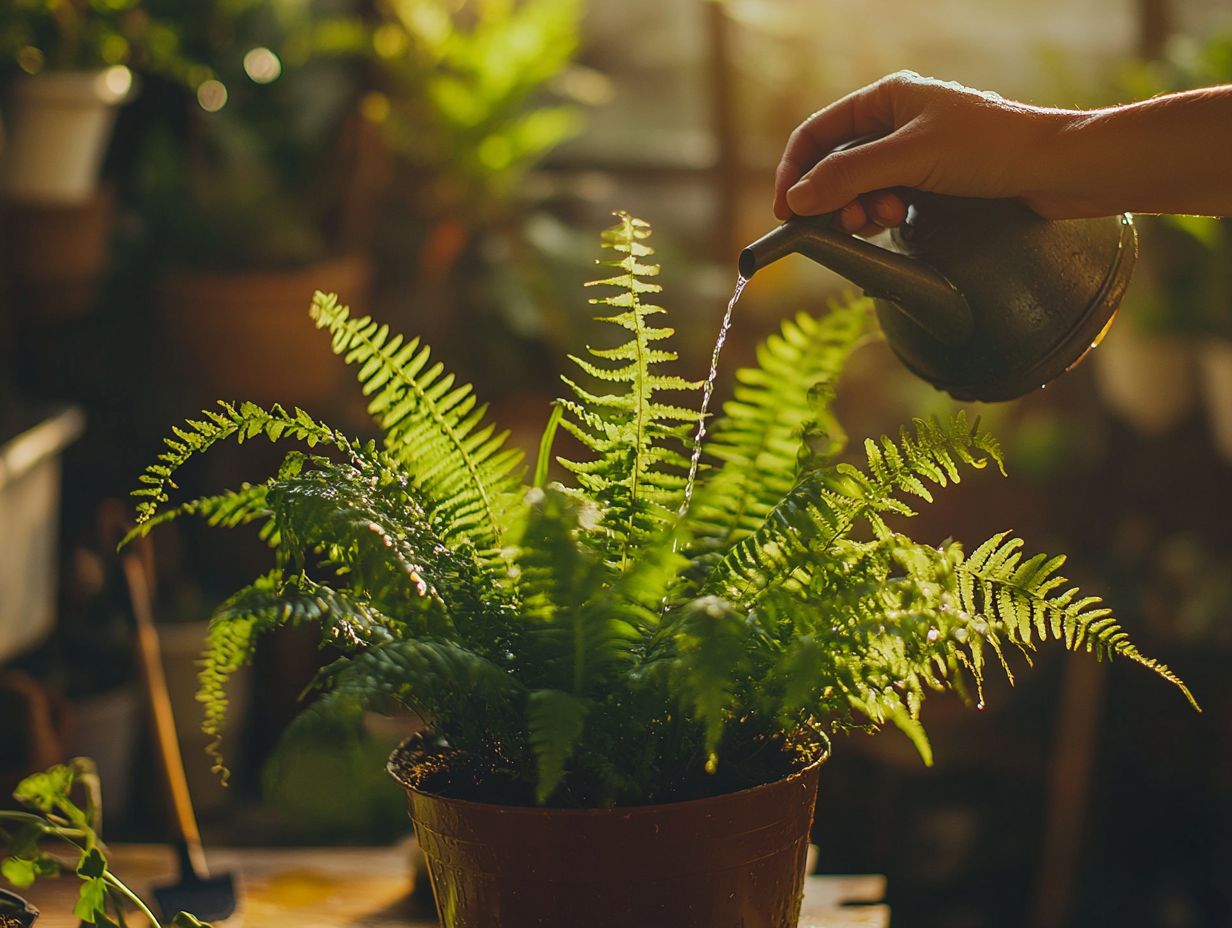
If the leaves of your ferns start turning yellow or brown, it is a sign of overwatering. You may also notice the soil becoming consistently wet or waterlogged. It is important to adjust your watering schedule to prevent root rot and other issues.
Can I use tap water to water my ferns?
It is best to use filtered, distilled, or rainwater when watering your ferns. Tap water can contain chlorine and fluoride, which can be harmful to your plants over time.
How often should I mist my ferns?
Ferns thrive in high humidity, so misting them once or twice a week can help to increase the humidity levels around them. This is especially important if your ferns are in a dry or arid environment.
Should I water my ferns from the top or bottom?
It is recommended to water ferns from the bottom by placing them in a tray of water for 10-15 minutes. This allows the plant to soak up water at its own pace and prevents overwatering. If you prefer to water from the top, be sure to avoid getting water on the leaves.
What should I do if my ferns are wilting?
Wilting ferns can signal underwatering or low humidity. Check the soil moisture and consider increasing the humidity around the plant by misting or using a humidifier. If the plant is severely wilted, you may need to repot it with fresh, well-draining soil and water it deeply.
Give your ferns the care they need, and watch them thrive!

